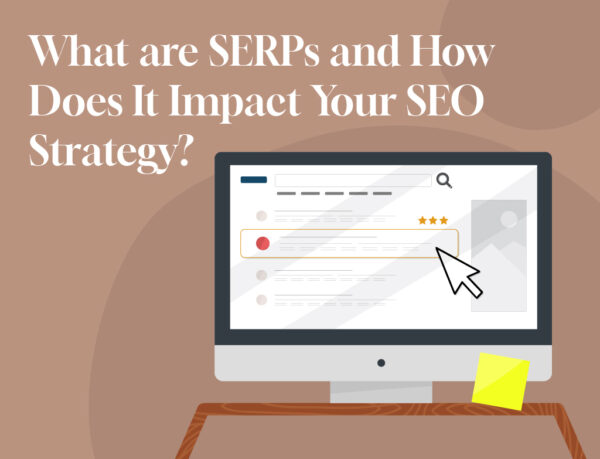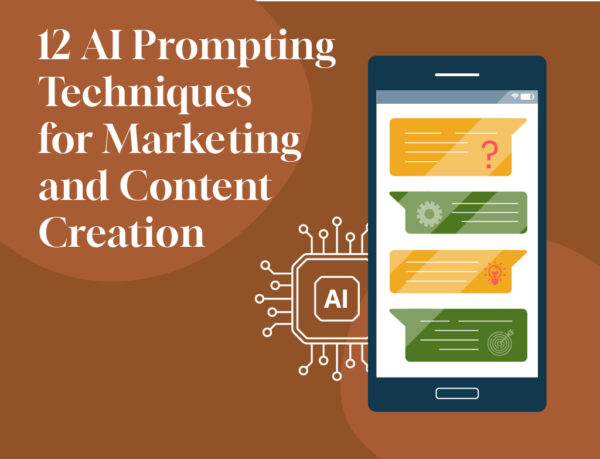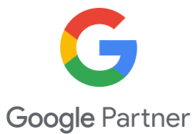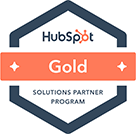The Ultimate Guide to SEO-Friendly Content
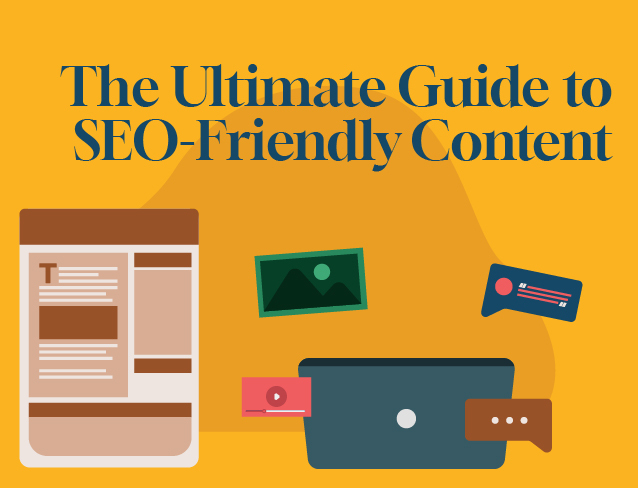
In This Article
Writing content for your website is part art and part science. It’s a dance between creating something engaging and helpful for the actual humans visiting your site and something with all the right technical elements for the algorithms that rank your content.
Luckily, search engines like Google strive to offer valuable content to their users. So, the content that ranks high on search engine results pages (SERPs) often aligns with what people are genuinely interested in reading.
The problem is that excellent content is sometimes lost deep within the rankings. This blog will help you better understand how search engine optimization (SEO) guidelines can help your content compete for one of the top spots on a SERP. We’ll walk through the entire process from pre-writing to post-publishing.
Once you have a better understanding of SEO and how to apply it, you’ll be able to create content that ranks well and can help drive increased organic traffic to your site.
Prewriting Tips

The blinking cursor in a new document can be intimidating. What should you write about? How do you know this content is worth your time and effort? We’ll outline an effective brainstorming process that will help you pinpoint content topics that have the potential to perform well.
Step 1: Set Your Content Goals
Content goals can vary depending on your overall marketing strategy, but some common goals include increasing website traffic, generating leads, boosting social media engagement, establishing brand authority, and driving sales.
Once you have defined your content goals, ensure they are specific, measurable, achievable, relevant, and time-bound (SMART goals). For example, instead of setting a goal to “increase website traffic,” set a goal to “increase website traffic by 20% over the next six months through targeted content marketing efforts.”
Step 2: Choose Between Trending and Evergreen Content
Now it’s time to decide on the content type. Do you want to contribute to a trending conversation or create something that might have a longer “shelf life”?
Trending content is popular and receives high traffic, shares, and engagement on social media platforms or search engines. Trending content is often highly time-sensitive and related to current events, news, or popular culture, and it may only be briefly relevant.
If your content goal is to generate traffic or increase brand awareness quickly on social media, trending content may help. However, you’ll need more than a trend to keep people returning.
Evergreen content is timeless and can generate traffic and engagement long after publication.
Finally, if your content goal is to drive sales, you might create a series of tutorials about your product or service.
Step 3: Identify the Persona
Who’s going to consume your content, and what do they want? Your buyer persona represents your ideal customer and helps you tailor your content to their needs, preferences, and pain points. Creating content that speaks directly to your persona enables you to establish a personal connection with your audience and build trust and loyalty over time.
Step 4: Conduct Keyword Research
Keyword research identifies and analyzes the keywords and phrases people use to search for information about your topic or industry. Keyword research is critical to creating content that ranks well on search engines.
To begin keyword research, brainstorm a list of relevant keywords and phrases related to your topic. Use tools like Google’s autocomplete or related searches to generate additional ideas.
Next, use keyword research tools like Google Keyword Planner, Ahrefs, Moz Keyword Explorer, and SEMrush to analyze your target keywords’ search volume, competition, and cost-per-click (CPC). These tools can help you identify high-traffic, low-competition keywords you can target for use in your content.
Understanding Intent
Keyword intent refers to the underlying motivation behind a user’s search query. Knowing the intent behind a keyword helps you create content that addresses the user’s search query.
There are generally four types of keyword intent:
- Navigational intent is when a user seeks a specific website or web page. They may type in a brand name, product name, or URL.
- Informational intent is when a user seeks information on a particular topic. They may be looking for answers to questions, definitions of terms, or general knowledge.
- Commercial intent is when a user actively shops for a product or service. They may include words like “buy,” “reviews,” and “prices.” They are in the decision-making phase of the buyer’s journey.
- Transactional intent is when a user wants to purchase or take a specific action, such as signing up for a service or downloading a resource. Examples of keywords with transactional intent include “buy now,” “sign up,” and “register.”
Long-Tail Keywords
Long-tail keywords are specific, targeted phrases with three or more words. While they may have a lower search volume, long-tail keywords are less competitive, and it can be easier for you to rank for them.
LSI Keywords
Latent semantic indexing (LSI) keywords are related phrases to your target keyword. For example, if you’re writing about “content marketing,” LSI keywords could be “content for SEO,” “SEO friendly articles,” and “SEO copywriting.” You’ll want to include several LSI keywords to complement your target keyword.
Step 5: Establish Context
Your article will live in an ecosystem of other content. There will be competitors who are likely to create similar content. And there might be additional content on your website that complements the article.
Competitive Research
The goal of any content is to add to the existing conversations around your topic. It’s not simply recreating the same topic everyone else has published. Competitive research might begin with using Google’s advanced search feature to see what content your competitors have created.
It might look something like this:

This strategy lets you browse the content from one specific website.
You’ll also identify who’s already ranking in the top spots on a search engine result page. Take note of how they structured their content, their word count, and if they’ve incorporated any multimedia elements.
You’re looking for your opportunity to break through the existing noise. Could you add more value or information? Do you have better examples, or can you answer the user’s question better?
Thinking in Topic Clusters
It’s not just your competitors who’ve created related content; you likely have content on your website that could support your new content efforts. To make the most of this content, think about it in terms of topic clusters.
A topic cluster is a group of related content pieces covering a broad topic in-depth. The content in a topic cluster should be linked, creating a network of content that provides comprehensive coverage.
Here is an example of how a cleaning company might approach topic clusters.
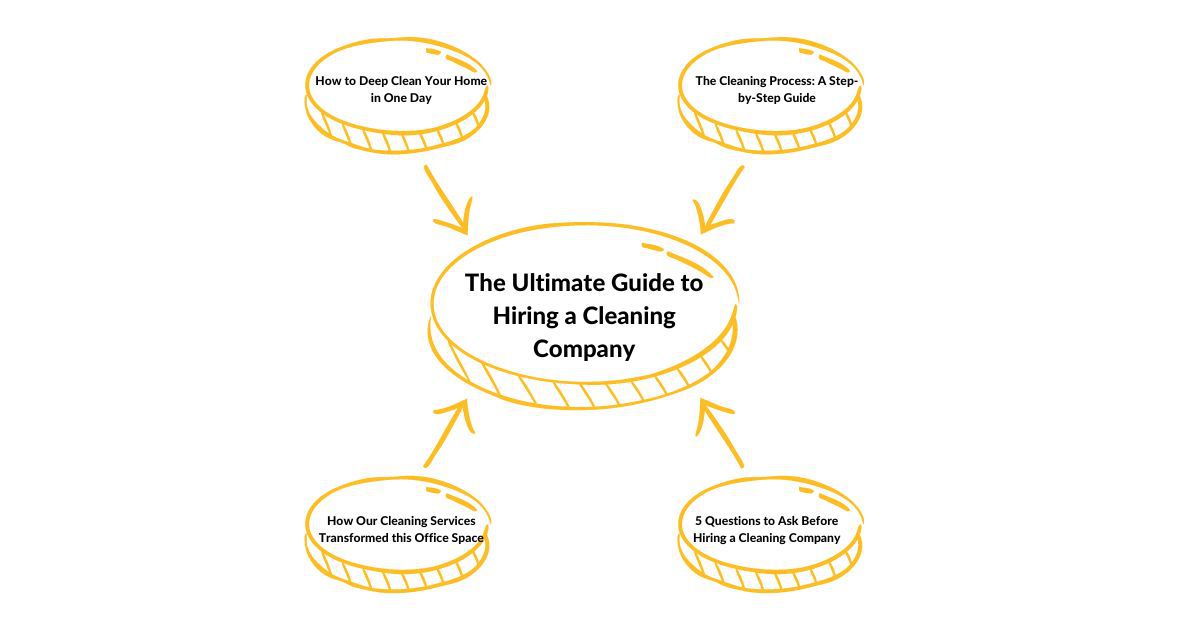
To create a topic cluster, identify a broad topic related to your industry or business. Then, create a pillar piece of content that covers that topic in-depth. Ideas could include a long-form blog post, an e-book, or a white paper.
Next, identify subtopics related to your pillar content and create individual pieces of content that cover each subtopic in-depth. These could be blog posts, videos, infographics, or other types of content.
Link each subtopic piece back to your pillar content, and link your pillar content back to each subtopic. Search engines prioritize websites with in-depth coverage of a topic; this strategy helps demonstrate that your website is a go-to resource for that particular topic.
Choose the Content Format
There are many content formats, like blog posts, e-books, infographics, videos, and podcasts. Each format has its strengths and weaknesses, so you’ll need to choose the one that will be most helpful for your audience.
If you want to provide detailed information on a specific topic, an e-book or a long-form blog post is a great choice. If you want to showcase your product or service, a video or infographic might be more effective.
How To Write Content That Search Engines and Users Love

What makes for robust and helpful content that humans will read and algorithms will love? Let’s start with word count. Gone are the days of short and sweet pages with 500 words or less. That being said, the ideal word count for a page of comprehensive content can vary depending on the topic and the content’s goals.
However, based on the latest data by SEMrush, a pillar page should aim to be at least 3,000 words or more. The ideal lengths for other content types are shorter; informational blogs should be between 1,000-1,500 words, and guides and how-tos should be between 1,500 and 2,500 words.
How long should your content be? That’s where competitive research comes in handy. Knowing what is already performing well on search engines will give you valuable insight.
While long-form content tends to perform better, quantity does not equal quality. Simply stuffing a page with words to meet a word count goal can lead to disjointed and difficult-to-read content. Instead, focus on providing valuable information and insight that is well-organized and easy to understand.
Word count is one of many things to consider when crafting SEO-friendly content. Here are some elements you’ll also want to consider.
Content Structure
Every page should have technical elements that make your content easy to read and simple for algorithms to understand and categorize your page.
URL
URLs provide context for search engines and users about a page’s content. You should keep your URL short (no more than five to seven words). And remove any stop words like “the,” “a,” and “and” that add little to no value to a URL. Finally, make it descriptive. Your URL should accurately describe the content of your page clearly and concisely.
Title Tags and Meta Descriptions
Title tags and meta descriptions are essential elements of on-page SEO that can help search engines understand your content and improve your visibility on search engine results pages.
Title tags are the clickable headlines that appear in SERPs, and they should accurately describe the page’s content while including the primary keyword. Title tags are one of the most important on-page SEO factors, as they give users a sense of what they can expect from your content and help search engines understand your content’s relevance to a particular search query.
Meta descriptions, however, are short bits of text that appear below the title tag on SERPs. While meta descriptions don’t directly impact your rankings, they are critical in attracting clicks and driving traffic to your site. A well-crafted meta description should provide a compelling summary of your content, including the primary keyword, and encourage users to click through to your site.
Headers and Subheaders
Headers and subheaders are HTML tags that structure a web page’s content. There are six levels of header tags (H1-H6).
Header tags are essential to SEO because they help search engines understand your page’s structure and content. Use header tags to break up your content into logical sections and prioritize the importance of each section to help search engines understand what your content is about and improve your rankings for relevant keywords.
Headers also prevent reader fatigue by helping users skim your content and easily find what they want.
Here are some best practices for using header tags for SEO:
- Use H1 tags for your page’s primary headline to ensure it accurately reflects its content.
- Use H2 tags for subheadings that introduce your content’s main sections.
- Use H3 and H4 tags for sub-subheadings or to break up long text sections into smaller, more easily digestible chunks.
- Use header tags consistently throughout your content to provide a clear and logical structure for users and search engines.
Multimedia Elements
Adding multimedia elements to your blog—from images and videos to infographics and interactive tools—can take your content from good to great.
Multimedia elements improve user experience (UX) by making your content more engaging and entertaining, and they also help with SEO. When users engage with your content for extended periods of time, it sends a positive signal to search engines that your content is high-quality and valuable. Plus, when readers share your multimedia content on social media, it can help increase your visibility and drive more traffic to your site.
A word of caution: Add multimedia elements carefully so they do not slow down your website’s load speed (another technical SEO ranking factor).
To make your multimedia elements user- and SEO-friendly:
- Optimize your image sizes so they’re manageable but easy to see without pixelation. The right size will vary depending on the element, but blog images typically range from 1200 x 630 px to 1280 x 720 px.
- Use descriptive file names and alt tags to provide context for search engines and visually impaired users.
- Provide transcripts for your audio and video content to improve accessibility and help search engines.
- Use responsive design to ensure your multimedia elements display correctly on all devices, including desktops, tablets, and smartphones.
- Host your videos on YouTube or Vimeo to improve load times and reduce the strain on your web hosting server. Also, YouTube videos can appear in Google’s video search results, which can drive additional traffic to your site.
Internal and External Links
Internal and external links are helpful because they increase your content’s credibility.
You can use internal links anywhere that makes sense to connect two pages within your website. Internal links provide additional context or background information. Or, if you’ve created content in topic clusters, you can use them to promote the related content.
External links provide sources for your readers. For example, if you write about a study because the data is relevant to your topic, you should link to that study in other content pieces. External links also provide additional resources to your readers. For example, if you can link to relevant tools or software.
The best strategy is to link to high-quality external websites (not low-quality spammy ones) and avoid packing your content with extraneous links. Instead, use internal and external links strategically and thoughtfully throughout your content.
Anchor Text
Anchor text refers to the clickable text that appears as a hyperlink on a web page. Use descriptive anchor text that accurately reflects the linked page’s content to help search engines and readers understand the relevance of the linked page to a particular search query.
Try this: Sprout Social’s 2023 benchmark report found that 66% of consumers said the most engaging format on social media is short-form video.
Not this: Sprout Social’s 2023 benchmark report found that 66% of consumers said the most engaging format on social media is short-form video. Click here to read the report.
Using “click here” in the example above as the anchor text for a link can be bad for SEO because it does not provide any context or relevant keywords to search engines about the destination page. In addition, “click here” is not very descriptive and doesn’t give users any indication of what they can expect to find on the linked page.
Keyword Density
Keyword density—calculated as a percentage—is the total number of times a keyword is found on a web page compared to the page’s total number of words. In the early days of SEO, website creators tried to stuff keywords to rank higher rather than focusing on creating quality content. Some pages even had hidden keywords in the website’s background, using the same font color as the website’s background color. However, these old “black hat SEO” strategies won’t work with modern SEO and will also negatively impact your website.
While there is no ideal keyword density, the consensus is that a 1-2% keyword density is reasonable. However, keyword density should not be the primary focus of your SEO strategy. Instead, aim to create high-quality content valuable to your users and incorporate relevant keywords naturally and organically.
Call to Action
A call to action (CTA) is a prompt or directive that encourages users to take a specific action, such as clicking a button, filling out a form, or purchasing. CTAs are essential for SEO because they can help drive your website’s engagement, conversions, and, ultimately, revenue. Every page on your website should have at least one CTA.
Your CTAs should be clear, concise, and compelling. Use action-oriented language that encourages users to take the desired action, and make sure your CTA stands out visually on the page.
Post-Publishing Tips

You’ll need to promote your content after you publish it to improve visibility and reach a wider audience.
Amplification aims to elevate your search engine rankings and drive additional traffic to your website.
Here are some strategies to boost your content:
- Promote your content on social media channels like Facebook, Twitter, Instagram, and LinkedIn to increase visibility and drive traffic to your website.
- Partner with influencers in your industry to promote your content to their followers and increase its reach.
- Use email marketing campaigns to promote your content to your subscribers and encourage them to share it with their networks.
- Syndicate your content on third-party platforms or partner websites to increase its reach and drive traffic to your website.
- Use paid promotion strategies, such as pay-per-click advertising or sponsored social media posts, to increase visibility and drive traffic to your website.
After you’ve planned, written, and promoted your new content, the last step is to dive into the data and see what is resonating (and what isn’t working) for your target audience.
Analyze Performance
Analyzing the performance of your website’s content is an integral part of SEO. You want to review your data regularly to see what content is performing well, which pieces need to be improved, and where you can find new opportunities for success.
Look at key metrics, such as page views, time on page, bounce rate, organic search ranking, and conversions, to gauge each piece of content’s performance. You can also look at other metrics, such as social media shares, comments, likes, and engagement, to better understand how your content resonates with your audience.
Update “Old” Content
We want all your hard work to pay off, so we’ll leave you with this final content strategy: update your “old” content.
Old content could be a year or ten years old, but either way, the content on your website needs a little dusting off from time to time. Updating is necessary because content can become outdated or irrelevant, particularly in fast-changing industries.
By refreshing your past published work, you can ensure it remains relevant and valuable to your audience. More importantly, search engines prioritize fresh, high-quality content. Updating old content with new information or insights can improve its search engine visibility and drive more traffic to your website.
Metric Marketing Can Craft SEO-Friendly Content for Your Business
Creating content that drives traffic and improves your website’s search engine rankings can be time-consuming. However, the rewards are well worth the effort.
At Metric Marketing, we understand how vital SEO-friendly content is for driving your business’s engagement, conversions, and revenue. Our experienced writers and SEO experts can craft targeted, SEO-friendly content to help you get the most out of your website and help you grow your business.
Contact Metric today to learn how we can help you create killer content for your business!
Must-read articles
Looking for something else?
There's so much more
Ready to Inquire?

